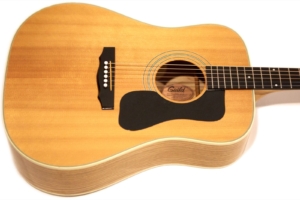
This is a fairly interesting guitar for a bunch of reasons, the most obvious being that the back and sides are solid ash. I tend to be drawn to uncommon Guilds, so let’s take a look and see how this one fares.
Introduction
I get a fair amount of disbelief over on the LetsTalkGuild forum because my favorite acoustic guitar is a Taylor. Being primarily an electric guitar player, I’ve always been drawn to Guild’s electric guitars, and since I didn’t own an acoustic through the ’80s and ’90s, I didn’t really develop a taste for the typical Guild (or even Martin) acoustic sound. Certainly, I’ve heard my share of acoustic songs and like the timbre of the instruments played on those recordings. The simple truth is that thanks to my years playing in bands, I have a degree of hearing loss that is centered around certain frequencies which I think may be the cause for my attraction to brighter-sounding guitars.
Since most Guilds don’t sound bright, I was intrigued when I first came across a Guild D46 because the entire guitar (except for the fretboard) is made from ash. Ash is not a typical tonewood in acoustic guitars, most likely because it produces a brighter timbre than the normal maple and rosewood materials used. The quality of the sound from a D46 is not quite like a Taylor and it’s certainly not like a traditional Guild, either. It’s its own thing.
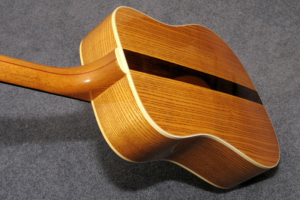
Since this model isn’t seen very often, people sometimes post that it was very limited or never became a production model or some other form of guitar-forum hearsay. The Guild D46 was very much a production guitar, and to quote author and renowned Guild collector Hans Moust, Guild made quite a few D-46s more than the ones that are listed on the ‘official’ serial number lists and for a longer period. We won’t know more about the details of how many were made until he publishes another book on the subject, but suffice to say that it appears as though they are not as rare as some sellers might have you believe.
The biggest variation I’ve seen on these D46s (aside from the center stripe) is the width of the grain on the back. This first example is from an old Elderly Instruments ad. Note that I shamelessly flipped the pic and removed the stand to make it match my picture below, but my point is to show the nice tight grain on the back of the guitar. As an aside, someone scored a great deal on this guitar because, though it was marked factory second, it also sold for only $450 which is a killer price for a guitar of this caliber, factory second or not. At any rate, notice the very tight grain throughout the wood on the back. That’s the kind of grain I tend to prefer when looking at a guitar made from Ash.
This next guitar is the one in my possession, and you can see that the wood grain is much wider. I have my doubts that the width of the grain affects tone assuming all else being equal because when it comes to acoustic instruments it’s practically impossible to make everything else equal. Every piece of wood should be evaluated on its own merits just like every guitar should be evaluated on its own merits. I’ll admit to wishing that my guitar had tighter grain on the back because, as already stated, I’m shallow when it comes to guitars. Really, though, the only people that see the back of the guitar are the person who picks it up out of the case and then possibly the people that person then shows it off to. After that, it’s all about the top or hopefully, and more importantly, the sound.
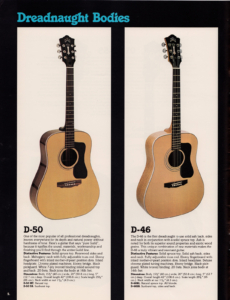
Two model numbers are shown: D-46BL with a natural spruce top and an all blonde finish, and D-46SB with a sunburst top, back, and sides. Mine is simply labeled D46-BLD on the sticker in the sound hole, though mine is a 1985 and the catalog shown appears to be from 1981 (Guild catalogs are rarely dated).
There didn’t seem to be a lot of fanfare about this model, and I was unable to find any magazine advertisements for it. That doesn’t mean that there weren’t any, but rather that my ability to search for them on the Internet met with frustration. That’s how it is with the Internet some days when you spend hours searching for a nice blonde. And no, I will not be making any jokes revolving around the phrase, “nice ash”.
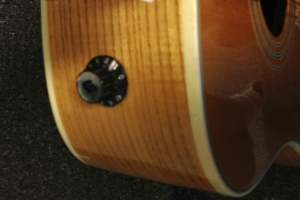
The case
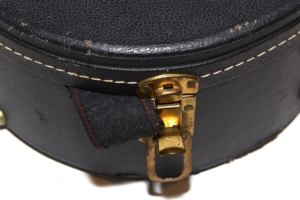
Finish
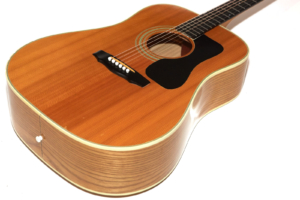
You may notice in some of the pictures what appears to be a darker band of spruce on the top down the center of the instrument. This is not quite as visible in normal light and seems to be highlighted by the flash when photographing the guitar and is further accentuated with the slight contrast tweak that my standard editing recipe has applied. Though the streaks are certainly prevalent, the guitar’s top doesn’t look like quite so much like two-colored wood as it does in the photos. The difference is there, though, and I find it almost appealing because it looks like a shadow drawn out from the bridge since the bridge and the darker center are almost exactly the same width.
While blonde and sunburst are shown as options in the catalog, sunburst seems to be pretty uncommon. Hell, this model already feels pretty uncommon, so I guess sunburst would be downright rare, though I try not to use the “r” word given it’s common abuse in the guitar world. I feel compelled to add that since I first wrote that paragraph, I’ve seen two sunburst D46 guitars for sale, so making judgments about what I’ve seen for sale on eBay and Reverb is probably not the best way to gather data.
Fretboard and Neck
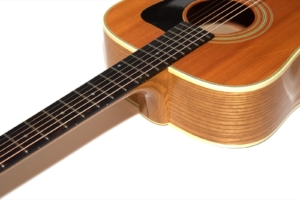
The neck on this particular guitar is arrow straight after 34 years and the guitar plays like a dream. I attribute this to the three piece neck design which I think adds a great deal of stability over single piece necks and I say that because of all the guitars I’ve owned (mostly Guilds), the ones with the three piece necks are the ones I’ve never had to adjust.
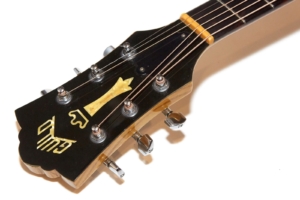
The frets are typical of Guilds from the ’80s which means that they’re a bit small, though having played a 1979 Guild S300 as my only guitar for 15 years, the frets don’t bother me at all. The fretboard radius is a pretty flat 20″ which is pretty standard for acoustics in my experience. I really like the playability of this guitar with the exception of one aspect, and it’s kind of a biggie for me.

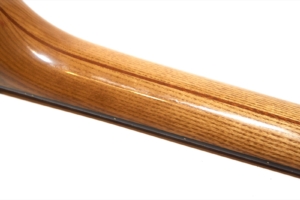
Build Quality
This is not really a high-end instrument when compared with other Guilds such as the venerable D55, and the reason I say that is that there is no binding, the inlays are simple dots, the body binding appears to be plastic, and so-on, but make no mistake: this is a damn nice guitar. Guild acoustics always feel very solid to me and I often joke that you could paddle a canoe with one (don’t do that). Hell, the Guild JF65-12 that I had felt like you could club someone over the head with it and it would stay in tune (don’t do that, either). My perception may be due to playing Taylors which, by comparison, feel like they’re made out of balsa wood. My guess is that Taylor use thinner pieces of wood all around, but I have no idea if that’s true. I still love my Taylor, but I feel like it needs to be babied where my Guilds feel like they need to be played and played hard.
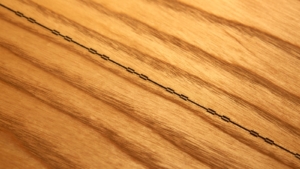
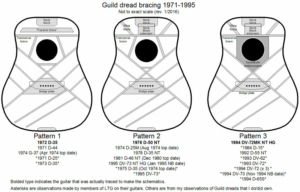
I can tell you that this guitar passes one of my own tests which is to say that no matter how hard I strum it I can not overdrive the top. I like an acoustic to push some serious air when I dig in, and I’ve had issues with some lower-quality instruments (and some surprisingly high-quality ones for that matter) that just couldn’t keep up with my aggressive right hand. This guitar, like most every Guild acoustic I’ve ever played, just takes it and asks for more.
Hardware
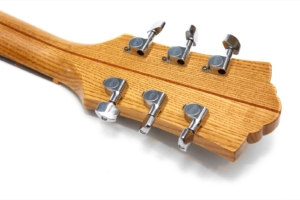
Really, that’s all the hardware there is on this guitar since it’s an acoustic and there are no pickups or knobs or anything else where metal might show up.
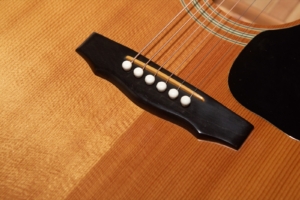
The nut and the bridge are both made of Micarta (Thanks Hans!), which according to Wikipedia is a brand name for composites of linen, canvas, paper, fiberglass, carbon fiber or other fabric in a thermosetting plastic… The term has been used generically for most resin impregnated fibre compounds… The article goes on to describe the applications for Micarta as including …kitchen tool handles, handgun grips, guitar fingerboards, nuts and bridges, pool cues, and safety gear such as hard hats. StewMac describes the Micarta they sell as being ivory in color and a bit softer than bone. They also state that Martin has used it for their nuts and saddles since the 1960s.
The elitist tinkering snob in me feels the need to replace the nut and saddle with bone, but the player in me likes the sound of this guitar as-is. I also appreciate vintage instruments that are original, so the guitar has remained unmodified in my hands.
Sound
This guitar has a very tight, very articulate tone that is best described as focused. It has a very nice high-end sparkle that really shines when a capo is used. If I capo on the 7th fret and pick out Hotel California, the overtones for the notes give just a hint of that 12-string sound that the original exemplifies even if I do battle the capo with my sausage fingers on the narrow fretboard. The only other acoustic I have that does this so well is my Taylor DN-K which has solid koa back and sides. The sustain on this guitar is fantastic, and the notes just ring and ring no matter what register.
With the capo down on the third fret, picking Jethro Tull’s Thick as a Brick delivers a wonderful tone as well. Since Ian Anderson famously played parlour-sized guitars including Martins and other brands, his acoustic tone tends to be a bit brighter than the typical large dreadnaught seen in most rock music. The subtleties of his tone can be hard to match with a typical acoustic, but I think this Guild D46 does an admirable job.
Open Chords #1
Open Chords #2
D-Shape Chords
Barre Chords
Hotel California
My God
Mother Goose
Mother Goose, from the same album, shows off not only the guitar’s timbre with a capo on the fifth fret, but also my complete inability to play at a consistent or even reasonable tempo. Of course the mistakes would probably have been lessened if I’d just slow the hell down, but then this article would have taken that much longer to complete.
I’m really not much of an acoustic player, and I really need to play one for a week or more straight before I feel comfortable with my playing, which is not what happened before I decided to record that Jethro Tull stuff. What’s more, I’ve had the guitar for about a year and played it non-stop when I got it but wasn’t smart enough to record myself (or if I did I didn’t label the recordings). I sat with the guitar for about an hour this time and just couldn’t deliver a good enough recording without embarrassing myself, but since this review has sat 90% completed for a freaking year I recorded some chords and let ‘er rip. Enjoy my public humiliation while I think about what I’ve done.
Since this is an acoustic guitar without electronics, I recorded it with my trusty Olympus LS10 recorder. I put the recorder on my desk (on a foam pad) and positioned the guitar with the sound hole about 18″ from the mics. I’m not very happy with the recordings (even aside from my playing) and might have to invest in a nice large diaphragm mic if I review any more acoustics. Note that I also play with a .50mm pick because I like the brightness and attack, so the guitar may sound quite different in your own hands.
Playability
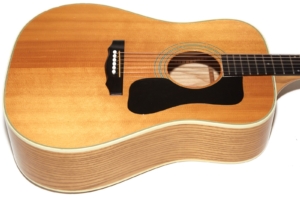
My only complaint is the 1 5/8″ neck, as previously covered, and though I wouldn’t mind griping a bit about the tiny tuners, they keep the guitar in tune just fine so it’s not like they affect the playability of the guitar. The neck width, though is the deal breaker for me. I absolutely love the timbre of this guitar and I love the way it plays, but the fretboard just isn’t wide enough for my fingers. While I can tolerate such a neck on an electric guitar, I play differently on an electric and spend a lot more time playing solos or other “electricy” type things, whereas on an acoustic I tend to play more, well, “acousticy” things and I just don’t feel like my fingers have enough room. If you have smaller hands then this may be the perfect guitar for you, assuming you’re OK with the big dreadnaught body.
Conclusion
I love this guitar but the fretboard is just too cramped for my long monkey fingers. As stated earlier if the fretboard was wider it would be an absolute winner for me. I you like a 1 5/8″ fretboard at the nut and you like a brighter sounding guitar, the Guild D46 should absolutely be on your short list.
Since this guitar is a Guild and is built like a Guild I feel like I could paddle a boat with it and then play all night around the campfire (seriously – don’t do that) without it going out of tune. The big dreadnaught body delivers all the acoustic volume I could ask for but with the extra bit of high-end that I prefer in an acoustic guitar. If you’re after the more traditional bass and mid-heavy sound of a rosewood back and sides guitar, though, this is not the instrument for you. Why conform, though? Embrace something different!
My quibbles about the fretboard width and the little tuners aside, this is a fabulous guitar, especially if you’re looking for something that’s a bit different than the standard recipe that most acoustics deliver. Besides, it’s a Guild, and you just can’t go wrong with a Guild.
Donate: PayPal Crypto:
ETH: 0x0AC57f8e0A49dc06Ed4f7926d169342ec4FCd461
Doge: DFWpLqMr6QF67t4wRzvTtNd8UDwjGTQBGs


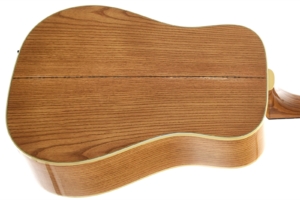
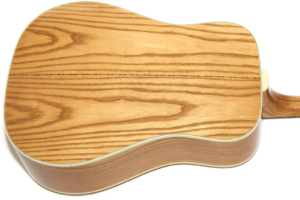
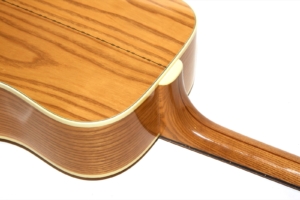
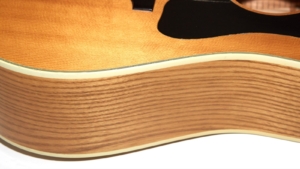
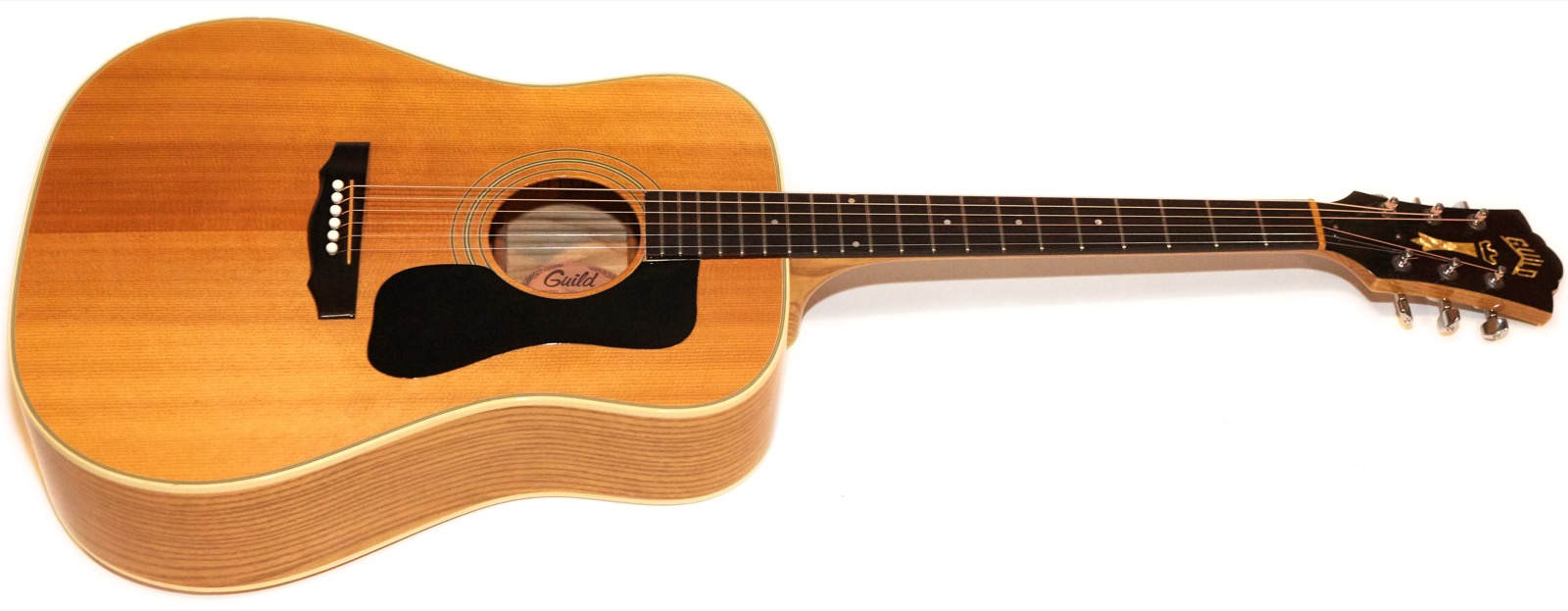
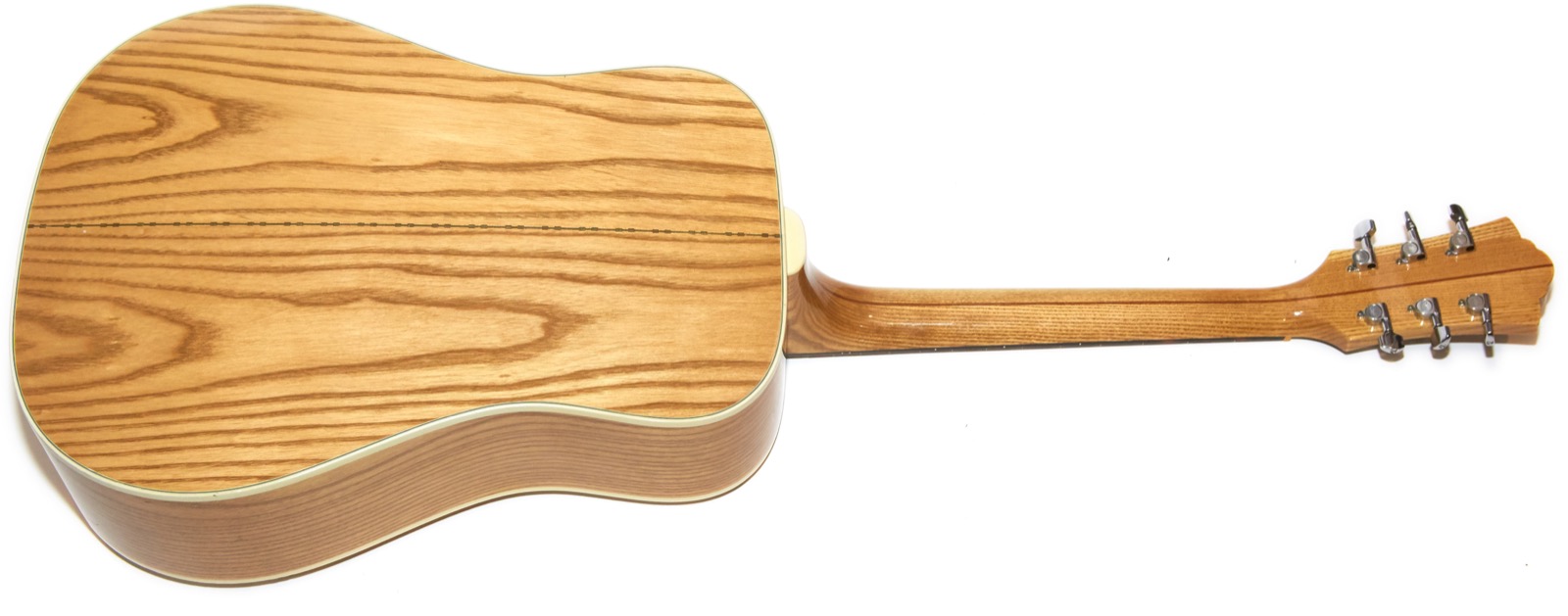
Greetings! I was the one that scored the great deal on the D46 from elderly instruments..
Anyways.. I currently have 5 Guild D46 guitars, simply because they are perfect for my hands and my style. I love the balanced tones and the way the individual notes sound and well as the sound when strummed light or hard. Extremely versitile guitars in every way.
All my Guild D46 guitars are from 1981 and 1982.. I have two that have the rosewood stripe in the back as well as an electric version.
However, the main reason I am commenting is simply this: All my Guild D46 guitars have the standard size tuners. Obviously, yours have the smaller ones. Why, I don’t know. Strange indeed.
Cheers!
Would you be interested in selling one of those D46’s. I have a personal connection with that model instrument and have been looking for one for quite a while.
Sorry, I no longer have the D46.
THERE IS ONE UP FOR AUCTION AT AUCTION NINJA.. IT ENDS ROUGHLY IN A BOUT A WEEK…. Sorry bout the caps.. I think it ends Dec. 5th
Hey Gad!
Your knowledge on guitars is mind boggling! 🙂
I have a very old strange acoustic guitar.. with no makers mark.. and what appears to be an ivory pickup board, and i was wondering if i could send you a couple of photos of it? Everyone who has seen it just scratches their head.. even guitar nerds i know.. but maybe with your fantastic knowledge, you might know what the hell this old thing is..
Sure, but I don’t know how much help I’ll be.
hi this is a old post but I have a 81 Ash with the stripe. They were released in 1981 and in 82 I believe the strip was gone. I read a article where the Rosewood Striped guitars were considered prototypes. not many were made before the change . anyways. along with my d50 -1973, Yairi dy61 1985, Epiphone Masterbilt 500.. 350 dollars !!. and Martin d18v- 2006.. Im happy. I must say that the ash just is a phenomenal player and no other guitar sounds like it. . its quite remarkable. My Yairi and Epiphone were perhaps the best buys and value. Yairi is every bit as good as my martin. just shows that you do not have to pay thousands for a great guitar. The Guild D-46 ash is just a one off amazing guitar…